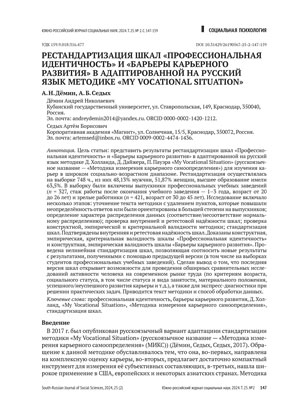Abstract
The objective of this paper is to present the findings of restandardization of the “Vocational Identity” and “Career Development Barriers” scales in the “My Vocational Situation” technique by D. Holland, D. Daiger, and P. Power. The Russian language version of the scale has been adapted to study careers in a wide socio-age range (the Russian-language title is “Методика измерения карьерного самоопределения” / Career Self-Determination Measurement Technique). The re-standardization was implemented on a sample of 748 individuals. Of these, 48.13% were male and 51.87% were female. Additionally, 63.5% had completed higher education. The sample included two groups of participants: vocational graduates (n = 327, with one to three years of post-graduation work experience, ages 20 to 26 years) and advancing-age workers (n = 421, ages 30 to 45 years). The study comprised several stages. Initially, the text of the methodology was refined by removing items that increased the uncertainty of answers or were oriented more towards graduates. Subsequently, the nature of data distribution was determined, specifically whether it complied with the normal distribution. The internal and retest reliability of the scales was then checked. This was followed by an examination of the construct, empirical and criterion validity of the technique. Finally, the scales were standardized. The internal and retest reliability of the scales were confirmed. The construct, empirical, and criterion validity of the scale “Vocational Identity” and the construct, empirical validity of the scale “Career Development Barriers” were demonstrated. A nonlinear standardization of the scales was conducted in order to facilitate the correlation of the new results with those obtained with the previous version, including those obtained with samples of vocational students. The latest version of the scales offers the potential for comprehensive comparative research on human activity in the contemporary labor market. This encompasses a range of factors, including age, social status, employment status, type of employment, material status, successful/unsuccessful career development, and so forth. Additionally, the technique and data processing method are provided, offering a framework for express diagnosis when solving practical tasks.
Keywords
References
Азбель, А.А. (2004). Особенности формирования статусов профессиональной идентичности старшеклассников (Автореферат кандидатской диссертации). Санкт-Петербург.
Белинская, Е.П., Бронин, И.Д. (2014). Адаптация русскоязычной версии опросника стилей идентичности М. Берзонски. Психологические исследования, 7(34). DOI: 10.54359/ps.v7i34.630
Дёмин, А.Н. (2022). Индекс прекарности для психологического изучения российского рынка труда. Организационная психология, 12(4), 103–122. DOI: 10.17323/2312-5942-2022-12-4-103-122
Дёмин, А.Н., Петрова, И.А. (2010). Психологические эффекты угрозы потери работы. Психологический журнал, 31(6), 38–49.
Дёмин А.Н., Пивкин Д.Ю. (2014). Разработка опросника «Психологическая структура занятости». Психология. Экономика. Право, 4, 18–29.
Дёмин, А.Н., Седых, А.Б., Седых. Б.Р. (2017). Стандартизация методики измерения карьерного самоопределения. Российский психологический журнал, 14(2), 151–170.
Шнейдер, Л.Б. (2007). Личностная, гендерная и профессиональная идентичность: теория и методы диагностики. Москва: Изд-во МПСИ.
Benach, J., Vives, A., Amable, M., Vanroelen, C., Tarafa, G., Muntaner, C. (2014). Precarious Employment: Understanding an Emerging Social Determinant of Health. Annual Review of Public Health, 35, 229–253. DOI: 10.1146/annurev-publhealth‑032013-182500
Fugate, M., Kinicki, A.J., Ashford, B.E. (2004). Employability: A Psycho-Social Construct, its Dimensions, and Applications. Journal of Vocational Behavior, 65(1), 14–38. DOI: 10.1016/j.jvb.2003.10.005
Fugate, M., Kinicki, A.J. (2008). A Dispositional Approach to Employability: Development of a Measure and Test of Implications for Employee Reactions to Organizational Change. Journal of Occupational and Organizational Psychology, 81(3), 503–527. DOI: 10.1348/096317907X241579
Gottfredson, G.D. (1999). John, L. Holland’s Contributions to Vocational Psychology: A Review and Evaluation. Journal of Vocational Behavior, 55(1), 15–40.
Giudici, F., Morselli, D. (2019). 20 Years in the World of Work: A Study of (Nonstandard) Occupational Trajectories and Health. Social Science and Medicine, 224, 138–148. DOI: 10.1016/j.socscimed.2019.02.002
Goldsmith, A.H., Sedo, S., Darity, W. Jr., Hamilton, D. (2004). The Labor Supply Consequences of Perceptions of Employer Discrimination During Search and on-the-job: Integrating Neoclassical Theory and Cognitive Dissonance. Journal of Economic Psychology, 25(1), 15–39.
Holland, J.L., Daiger, D.C., Power, P.G. (1980). My Vocational Situation. Palo Alto, CA: Consulting Psychologists Press.
Holland, J.L., Johnston, J.A., Asama, N.F. (1993). The Vocational Identity Scale: A Diagnostic and Treatment Tool. Journal of Career Assessment, 1(1), 1–11.
Nauta, M.M. (2010). The Development, Evolution, and Status of Holland’s Theory of Vocational Personalities: Reflections and Future Directions for Counseling Psychology. Journal of Counseling Psychology, 15(1), 11–22.
Reardon, R.C., Lenz, J.G. (1999). Holland’s Theory and Career Assessment. Journal of Vocational Behavior, 55, 102–113.
Santos, P.J. (2003). Goal Instability, Self-Esteem, and Vocational Identity of High School Portuguese Students. Análise Psicológica, 2, 229–238.
Smitina, A. (2010). The Link between Vocational Identity, Study Choice Motivation and Satisfaction with Studies. Procedia — Social and Behavioral Sciences, 5, 1140–1145.
Super, D.E. (1990). A Life-Span, Life-Space Approach to Career Development. In D. Brown, L. Brooks (Eds.) Career Choice and Development (pp. 167–261). San Francisco: Jossey-Bass.
Tosado, L.A. (2012). An Exploratory Study of a Measure of Vocational Identity for Spanish-speaking Persons (Candidate Dissertation). Maryland.


